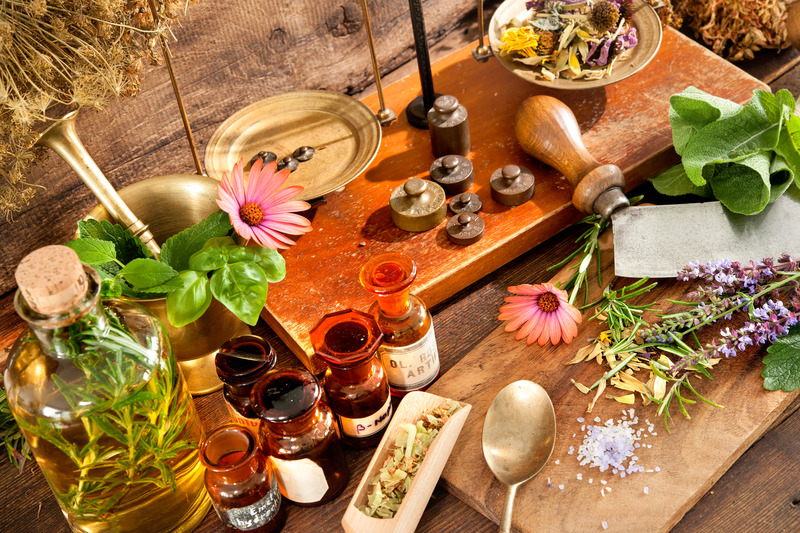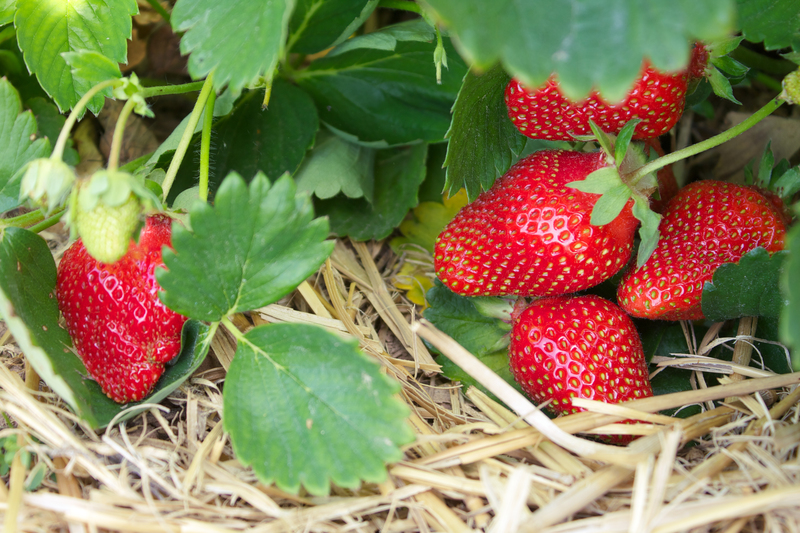Discover the Joys of Growing a Personal Herb Garden
Posted on 30/08/2025
Discover the Joys of Growing a Personal Herb Garden
Imagine stepping outside your kitchen door and snipping fresh basil, rosemary, or mint to add vibrant flavor and enticing aroma to your meals. Growing your own personal herb garden is not only rewarding, but it can also contribute to a healthier lifestyle and a more sustainable home. Whether you're an experienced green thumb or a complete novice, cultivating a herb garden at home is an accessible and versatile hobby that pays off in countless ways.
Why Start a Personal Herb Garden?
There's a special kind of joy in nurturing plants from seed or seedling to harvest. Growing a personal herb garden offers both tangible and intangible benefits, making it an ideal project for gardeners of all levels.
- Freshness and Flavor: Homegrown herbs surpass store-bought alternatives in both taste and scent. You can pick exactly what you need, when you need it, ensuring peak flavor.
- Saves Money: Culinary herbs at supermarkets can be surprisingly expensive. Cultivating your own cuts ongoing costs drastically.
- Healthier Meals: Fresh herbs contain higher amounts of essential oils, antioxidants, vitamins, and phytonutrients. Adding them to dishes increases both nutrition and taste.
- Sustainability and Eco-Friendliness: Reduce plastic waste from packaging and shrink your carbon footprint by minimizing commercially grown and shipped produce.
- Therapeutic and Satisfying: Gardening reduces stress and increases feelings of well-being. Tending to your herb patch can become a beloved daily ritual.

Choosing the Right Location for Your Herb Garden
The success of your personal home herb garden begins with thoughtful site selection. Most popular herbs thrive in sunny locations with well-drained soil or high-quality potting mix. Here's what to consider:
- Sunlight: Nearly all herbs prefer at least 6 hours of direct sunlight each day. If you have an apartment, select a south-facing window or balcony for container growing. Outdoors, a spot away from dense shade is best.
- Soil: Good drainage is crucial. If growing in the ground, amend heavy clay or sandy soils with compost. For containers, use a specialized herb potting mix or a combination of peat, perlite, and compost.
- Water Access: Herbs need regular moisture but dislike soggy roots. Raised beds, window boxes, or grouped containers can help you manage watering efficiently.
- Convenience: The closer your herb garden is to your kitchen or living space, the more likely you'll use those fresh sprigs in meals and drinks.
Container Gardening vs. In-Ground Planting
One of the beauties of growing your own personal herb garden is the flexibility of your setup. If you have limited space, an indoor or balcony herb garden can thrive in pots, planters, or even wall-mounted vertical gardens. For those with yards or allotments, traditional garden beds or raised beds allow room for larger harvests.
- Containers: Great for renters, urban dwellers, or anyone with limited outdoor space. Containers can be moved to follow sunlight and brought indoors during frost.
- In-ground Beds: Best for gardeners with space to expand. Allows for larger herb varieties and self-seeding annuals to establish themselves year after year.
Best Herbs for Beginners
Some herbs are wonderfully forgiving for new gardeners and ideal for starting your herb garden at home. Consider these easy-grow favorites:
- Basil: A classic herb for pestos, salads, and pastas. Prefers warmth, rich soil, and steady moisture.
- Mint: Exceptionally hardy, with fragrant, fast-growing leaves. Best grown in pots to prevent invasive spreading.
- Parsley: Resilient and high-yielding, parsley delivers harvest after harvest. Works well in containers and garden beds alike.
- Chives: Perennial, easy to grow, and adds mild onion flavor. Snip the leaves regularly to encourage lush growth.
- Rosemary: Likes hot, dry soil and full sun. A long-lived perennial with piney, aromatic branches.
- Thyme: Robust, drought-tolerant, and flavorful. Perfect for both pots and as ground cover in sunny beds.
- Cilantro (Coriander): Fast-growing, but bolts quickly--succession sowing ensures a non-stop supply.
- Sage: Hardy, aromatic, and a must in savory dishes. Prefers well-drained soil and plenty of sun.
Tip: Start with three or four herbs you love and cook with regularly.
How to Start Your Personal Herb Garden: Step-by-Step Guide
Ready to embark on your herb gardening journey? Follow this straightforward plan to cultivate a thriving home herb garden:
-
Choose Your Location:
- Identify a spot with full or partial sun (at least 6 hours daily).
- Determine if you're planting in beds, raised beds, or containers.
-
Select Herb Varieties:
- Pick herbs based on your cooking preferences and growing conditions.
- Purchase healthy seedlings from a nursery, or sow seeds for annual varieties.
-
Prepare the Soil or Potting Mix:
- Mix in plenty of compost for in-ground gardens.
- For containers, use a loamy, well-draining mix designed for herbs.
-
Plant Your Herbs:
- Gently remove seedlings from nursery pots and set into the soil at the same depth they were growing before.
- Space out plants according to their mature size to ensure good airflow.
- Water thoroughly after planting.
-
Mulch and Water:
- Mulch around plants to retain moisture and deter weeds.
- Water regularly, aiming for moist, not soggy, soil. Most herbs prefer to dry slightly between waterings.
-
Fertilize Sparingly:
- Herbs generally don't need much fertilizer. A light monthly dose of organic liquid fertilizer is sufficient.
Tips for Healthy and Thriving Herbs
- Regular Harvesting: Snip herbs often; this encourages bushier, more productive plants. Never harvest more than one-third of the plant at a time.
- Watch for Pests: Keep an eye out for aphids, spider mites, and snails. Discourage infestations by keeping plants healthy and removing pests by hand or with organic sprays.
- Prune and Deadhead: Pinch off flowers from annual herbs like basil to prolong leaf production. Groom perennials such as rosemary and sage to keep them tidy.
- Rotate and Refresh: Rotate pots or move plants seasonally to optimize sun exposure and prevent soil depletion.
Pro Tip: Herbs like mint, lemon balm, and oregano can overtake garden beds. Contain vigorous growers in pots to avoid them crowding out more delicate varieties.
Year-Round Growing: Bringing Your Herb Garden Indoors
If cold weather or limited exterior space is a concern, don't worry--you can enjoy a thriving indoor herb garden all year long!
- Choose Compact Herbs: Basil, parsley, chives, oregano, and thyme excel on bright windowsills.
- Use Quality Containers: Make sure pots have drainage holes. Place a saucer underneath to catch any excess water.
- Maintain Moisture: Indoor air can be dry, so check soil frequently and mist leaves if needed.
- Supplement with Grow Lights: If your space lacks sunlight, a small LED grow light ensures herbs receive the energy they need.
- Feed Occasionally: Use an organic liquid feed every few weeks since nutrients leach from containers with repeated watering.
Creative Ideas for Personal Herb Gardens
Your herb garden doesn't have to be conventional or boring. Consider these inventive, attractive ways to grow and display your edible greens:
- Mason Jar Windowsill Gardens: Upcycle glass jars as quirky mini-planters for kitchen herbs.
- Vertical Pallet Herb Gardens: Attach pots or grow directly in soil-filled pockets on an upcycled pallet leaned against a sunny wall.
- Hanging Basket Herb Displays: Free up counter space and create a living curtain of scent and flavor.
- Tiered Ladder Planters: Use an old ladder or plant stand to showcase a collection of beautiful potted herbs at different levels.
- Community Herb Circles: Collaborate with neighbors or friends to create a shared garden, each growing different herbs for communal harvest.
Harvesting, Storing, and Using Your Herbs
The joy of cultivating your own herb garden is never more apparent than when you start harvesting and using those vibrant green leaves. For best results, learn the optimal techniques for picking and storing herbs:
- When to Harvest: Cut leafy stems in the morning after dew has dried but before sun heats up and essential oils fade. Harvest frequently to keep plants lush.
- How to Harvest: Use clean scissors or garden shears. Pinch off top leaves and tender stems, leaving enough leaves so the plant continues to thrive.
- Storing Fresh Herbs: Place stems in a jar of water and cover loosely with a plastic bag in the fridge for up to a week. For hardy herbs like rosemary or thyme, wrap in a damp paper towel and seal in a bag.
- Drying and Freezing:
- Air dry bundles of hardy herbs in a warm, ventilated place out of direct sun.
- For tender herbs, lay out leaves on a tray or oven-dry at low temperature.
- Freeze chopped herbs in ice cube trays with olive oil or water for instant flavor bombs.
Simple Ways to Use Homegrown Herbs
- Add to soups, sauces, salads, and teas for a burst of flavor and nutrients.
- Blend into pesto, herbed butters, or marinades.
- Infuse oils or vinegars for gourmet gifts and cooking staples.
- Dry sprigs for potpourri, sachets, or herbal teas.
Health Benefits of Fresh Garden Herbs
Herbs are powerhouses of nutrition and wellness, in addition to being delicious. Growing a home herb garden lets you reap their full benefits, including:
- Antioxidant Content: Herbs like oregano, thyme, and parsley fight free radicals and support immunity.
- Digestive Aid: Mint, fennel, and basil help soothe digestion and alleviate bloating.
- Anti-inflammatory Properties: Rosemary and sage can reduce inflammation and boost cognitive function.
- Vitamins and Minerals: Leafy herbs are a source of vitamin K, vitamin C, and potassium.
- Calorie-Free Flavor: Herbs add taste without fat, salt, or calories--great for balanced, healthful nutrition!

Common Challenges and How To Overcome Them
Even with the best intentions, growing your own herb garden can present a few challenges. Here's how you can succeed:
- Poor Growth: Usually caused by inadequate sun or overwatering. Relocate your garden to a brighter spot and let the soil partly dry between waterings.
- Wilting: Signs of root rot or disease. Check pot drainage and remove any soggy soil.
- Pest Issues: A blast of water or natural insecticidal soap works against aphids. Use copper tape or crushed eggshells to deter snails and slugs.
- Lack of Flavor: Herbs grown in overly rich soil or over-fertilized may lose their signature taste. Lean, fast-draining soils are ideal for aromatic foliage.
Conclusion: Savor the Joy of Your Personal Herb Garden
There's no substitute for the pleasure and pride of tending to a personal herb garden. You'll enjoy enriching your meals with fresh, flavorful greens, develop a deeper connection to what you eat, and experience the restorative power of nurturing living things. Whether you have a sprawling backyard or a sunny windowsill, starting a herb garden is a joyful, practical, and sustainable step you can take today.
So gather your pots, select your seeds or seedlings, and let your journey into the enchanting world of herb gardening begin. Discover the happiness of a homegrown kitchen, one leaf at a time!

